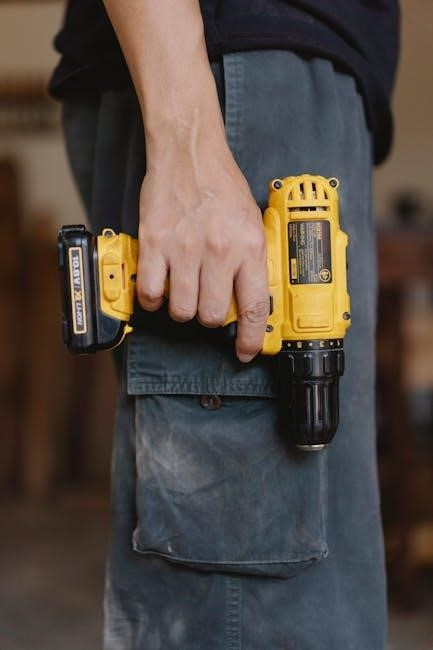Tascam DR-40 Manual: A Comprehensive Guide
This guide serves as a comprehensive resource for Tascam DR-40 users, covering everything from basic operation to advanced techniques․ Whether you’re a beginner or a seasoned professional, this manual will help you unlock the full potential of your DR-40 recorder and enhance your audio recording experience․

The Tascam DR-40 is a versatile, portable digital audio recorder designed for musicians, journalists, podcasters, and anyone needing high-quality audio capture in various environments․ This device is renowned for its four-track recording capabilities, allowing for simultaneous recording from multiple sources, making it ideal for capturing live performances, interviews, and field recordings․
Equipped with adjustable built-in stereo microphones, the DR-40 provides flexibility in capturing audio with different polar patterns, catering to various recording scenarios․ Its intuitive interface and comprehensive feature set, including overdubbing, variable speed playback, and versatile input options, empower users to create professional-grade recordings with ease․ This manual aims to guide users through the DR-40’s functionalities, providing a step-by-step approach to mastering its features․ By offering a blend of simplicity and advanced options, the Tascam DR-40 stands as a reliable tool for capturing pristine audio in any setting․ Understanding its capabilities is the first step towards achieving exceptional recording results․
Overview of Features and Functions

The Tascam DR-40 boasts a rich set of features designed to cater to diverse recording needs․ At its core, it offers four-track recording, enabling users to capture multiple audio sources simultaneously, such as stereo microphones and external inputs․ The adjustable built-in stereo microphones can be configured in either an A-B or X-Y pattern, providing flexibility in capturing different stereo images, with the A-B configuration offering a wider stereo field and the X-Y setup providing more focused sound․
The DR-40 supports high-resolution recording up to 96kHz/24-bit, ensuring pristine audio quality․ It includes XLR/TRS combo jacks with phantom power, accommodating both microphones and line-level sources․ The device also features overdubbing, allowing users to add layers to their recordings, and variable speed playback, useful for transcription and practice․ Furthermore, the DR-40 offers a built-in speaker for immediate playback, USB connectivity for file transfer and external power, and a range of recording modes to optimize for different scenarios․ These features combine to make the DR-40 a versatile tool for various recording applications․
Understanding the Controls and Connectors
Familiarizing yourself with the Tascam DR-40’s controls and connectors is essential for efficient operation․ The front panel features essential buttons such as record, play/pause, stop, and menu․ The input level knobs allow precise adjustment of recording levels for each channel, while the headphone output with dedicated volume control enables accurate monitoring․ The LCD screen displays crucial information, including recording levels, file names, and battery status, ensuring you’re always informed․

On the sides, you’ll find the XLR/TRS combo jacks for connecting external microphones or line-level sources, offering versatile input options․ The USB port facilitates file transfer to computers and can also provide power to the device․ The DR-40 also features a remote input for connecting optional remote controls, providing hands-free operation․ The power switch and battery compartment are located on the bottom․ Understanding the function and placement of each control and connector empowers users to effectively manage their recordings․
Basic Recording Setup and Operation
To begin recording with the Tascam DR-40, first, insert an SD card into the designated slot․ Then, power on the device using the power switch․ Connect your desired microphones or line-level sources to the XLR/TRS combo jacks, ensuring they are securely connected․ Adjust the input level knobs to achieve optimal recording levels, avoiding clipping or excessive noise․ Navigate the menu using the navigation buttons to select the desired recording format, such as WAV or MP3, and sample rate․
Position the microphones appropriately to capture the sound source effectively․ Press the record button to initiate recording, and the display will indicate the recording status․ Monitor the audio through headphones to ensure the sound is clear and balanced․ Use the play/pause button to temporarily stop and resume recording․ Once finished, press the stop button to end the recording, and the file will be saved automatically to the SD card․ Finally, power off the device when not in use to conserve battery life․
Advanced Recording Techniques
Explore advanced recording capabilities with the Tascam DR-40 by utilizing features like overdubbing, which allows layering additional audio tracks onto an existing recording․ Experiment with mid-side (MS) stereo recording for enhanced spatial imaging, using the built-in MS decoder to adjust the stereo width during post-processing․ Implement pre-recording buffer to capture audio moments before pressing the record button, ensuring you never miss crucial sounds․ Utilize the self-timer function to delay recording starts, ideal for solo performances․
Employ non-destructive editing functions like trimming and dividing files directly on the device, streamlining your workflow․ Explore the dual recording mode to capture a backup recording at a lower level, safeguarding against unexpected peaks and distortion․ Connect external effects processors via the line inputs to add creative textures during recording․ Use phantom power to operate condenser microphones requiring external power sources․ Master these advanced techniques to elevate your recording quality and creative possibilities with the Tascam DR-40․
File Management and Folder Operations
Effectively manage your audio files on the Tascam DR-40 through organized folder operations․ Create new folders to categorize recordings by date, project, or event․ Navigate through existing folders using the intuitive menu system․ Rename files directly on the device for clear identification․ Delete unwanted files to free up storage space on your SD card․ Protect important files from accidental deletion by utilizing the file protection feature;
Transfer files to your computer for editing, archiving, or sharing using the USB connection․ Back up your recordings regularly to prevent data loss․ Optimize file naming conventions for efficient searching and retrieval․ Utilize the DR-40’s file management tools to maintain a well-organized and easily accessible library of audio recordings․ Understand the device’s file structure to quickly locate specific recordings․ Learn how to recover accidentally deleted files using third-party software․ Mastering file management ensures efficient workflow and preserves your valuable audio assets․
Using USB Select and Connectivity
The Tascam DR-40 offers versatile USB connectivity options, selectable through the “USB Select” menu․ Choose between different modes, such as “Storage” for file transfer and “Audio Interface” for direct recording to your computer․ In “Storage” mode, the DR-40 functions as a mass storage device, allowing you to drag and drop files between the recorder and your computer․ This simplifies file management and backup procedures․
In “Audio Interface” mode, the DR-40 transforms into a high-quality audio interface, enabling you to record directly into your DAW (Digital Audio Workstation)․ Utilize the DR-40’s preamps and converters for pristine audio capture on your computer․ Control input levels and monitoring directly from the DR-40․ Ensure proper driver installation for seamless integration with your operating system․ Explore the advanced settings within your DAW to optimize the DR-40’s performance as an audio interface․ Troubleshoot common connectivity issues by checking cable connections and driver compatibility․ The USB connectivity expands the DR-40’s functionality, making it a valuable tool for both field recording and studio production․
Troubleshooting Common Issues
Encountering issues with your Tascam DR-40? This section addresses common problems and offers solutions․ If the DR-40 fails to power on, first check the batteries or AC adapter connection․ Ensure batteries are fresh and properly inserted, or verify the adapter is securely plugged in․ For recording problems, confirm the input levels are appropriately set and the correct input source is selected․
If audio is distorted, reduce input gain or adjust the limiter settings․ If files are not being recorded, verify that an SD card is inserted and properly formatted․ Error messages on the display usually indicate a specific problem; consult the manual for clarification․ USB connectivity issues can often be resolved by reinstalling the drivers or trying a different USB port․ For unresponsive controls, try resetting the device to its factory settings․ If problems persist, refer to the Tascam website for further support resources or contact their customer service․ Regular firmware updates can resolve many software-related glitches․
Power Options: Batteries, AC Adapter, and USB
The Tascam DR-40 offers versatile power options to suit various recording scenarios․ It can be powered by three AA batteries, providing portability for field recordings․ Ensure you use high-quality batteries for optimal performance and extended recording time․ Alternatively, an optional AC adapter, specifically the Tascam PS-P520E, can be used for continuous power during studio sessions or long interviews․
The DR-40 can also be powered via USB connection to a computer․ When connected to a computer, the DR-40 can draw power from the USB bus, eliminating the need for batteries or an AC adapter․ However, note that USB power may not provide sufficient power for all functions, especially when using phantom power for microphones․ It’s recommended to use an external power source for critical recording situations to avoid interruptions; Always check the power source switch setting to ensure the DR-40 is drawing power from the intended source․

SD Card Compatibility and Usage
The Tascam DR-40 utilizes SD cards as its primary storage medium․ The device is compatible with SD cards ranging from 64MB to 2GB and SDHC cards from 4GB to 32GB, offering flexibility in storage capacity․ It is crucial to use compatible SD cards to ensure proper operation and data integrity․ Before using a new SD card, it is recommended to format it within the DR-40 to optimize its performance with the device․
To format an SD card, navigate to the menu settings and select the format option․ Formatting will erase all data on the card, so ensure you have backed up any important files beforehand․ When inserting or removing SD cards, power off the DR-40 to prevent data corruption․ Regularly check Tascam’s website for the latest SD card compatibility list to ensure your card is supported․ Avoid using generic or low-quality SD cards, as they may cause recording errors or data loss․ Always handle SD cards with care to prevent physical damage․

Leave a Reply
You must be logged in to post a comment.